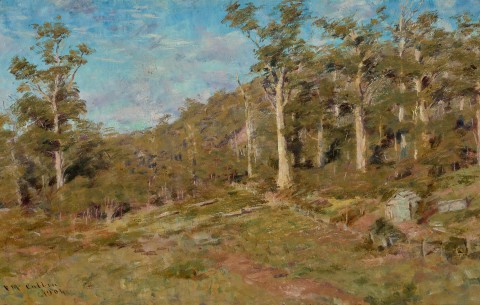THE HILLSIDE, MACEDON, 1904
FREDERICK McCUBBIN
oil on canvas
51.0 x 76.5 cm
signed and dated lower left: F McCubbin . / 1904
bears inscription with title on backing verso: HILLSIDE, MACEDON CAT NO 12
Private collection
Danuta and Ted Rogowski, Melbourne
The Rogowski Collection, Leonard Joel, Melbourne, 23 February 1998, lot 39
The Cbus Collection of Australian Art, Melbourne, acquired from the above
probably: Mr Fred McCubbin's Exhibition of Australian Paintings, Upper Athanaeum Hall, Melbourne, 22 April 1904
Selected Australian Works of Art, Lauraine Diggins Gallery, Melbourne, May 1984, cat. 11 (illus. in exhibition catalogue)
A Happy Life: Frederick Mccubbin's Small Paintings & Oil Sketches, National Gallery of Victoria, Melbourne, 1991, and touring, cat. 12 (bears inscription on backing board verso)
Overland, Latrobe Regional Gallery, Victoria, 10 March – 15 July 2012
Colour and Movement, Benalla Art Gallery, Victoria, 19 February – 9 June 2016
on long term loan about Geelong Gallery, Victoria
‘Art Notes. Mr McCubbin’s Exhibition of Paintings’, The Age, Melbourne, 22 April 1904, p. 8
Art and Australia, Fine Arts Press, Sydney, vol. 21, no. 3, autumn 1984, p. 285 (illus.)
Clark, J., A Happy Life, Frederick Mccubbin Small Paintings and Oil Sketches, National Gallery of Victoria, Melbourne, 1991, cat. 12, pp. 17 (illus.), 21
Nainby, B., Stanhope, Z., and Furlonger, K., The Cbus Collection of Australian Art, in association with Latrobe Regional Gallery, Melbourne, 2009, pp. 16, 32 (illus.), 226
We are grateful to Brenda Martin Thomas, wife of the late David Thomas AM, for kindly allowing us to reproduce David's research and writing in this catalogue entry.
When Frederick McCubbin moved to Macedon in 1901 he entered upon, as his son Alexander later wrote, 'the most fertile and vigorous period of his life.’1 Some of his best and most popular works soon followed including his masterpiece, The Pioneer, 1904, 'an established favourite' within a short time of its acquisition in 1906 by the National Gallery of Victoria through the Felton Bequest.2 When Childhood Fancies, 1905 (private collection) was first exhibited, the art critic for The Age wrote enthusiastically, 'McCubbin has never painted a more happily inspired picture.’3 And in Lost, 1907, (National Gallery of Victoria), another gem from this period, both the narrative and the early morning light filtering through the Macedon bush captured the public's imagination. McCubbin devoted himself enthusiastically to the subjects around him – 'The bush up our way looks more charming than ever', McCubbin wrote to his friend Tom Roberts in 1904. 'Pictures everywhere.’4 As the gifted interpreter of the secluded glade, he delighted in capturing the play of light in the subtlest of colours, of lyrical moments of childhood and the heroic endeavours of the early settlers of Victoria, the triptych format as much in veneration of the bush itself as of the pioneers.
Significantly, McCubbin named their family Macedon home 'Fontainebleau' after the forest in France, neighbouring the village of Barbizon and its school of plein air painters, and especially McCubbin's favourite, Corot. Devoting himself to painting in the open air, he even dug a trench in the ground so that he could reach the canvas tops of The Pioneer. Now in the middle years of his art, his style became broader and vision fresher in response to painting out-of-doors directly from the motif, encapsulated in the present Hillside, Macedon, 1904. The smoothly painted, tight style of earlier years gives way to the freer, textured brushstroke and palette knife – transitions which are clearly visible in the comparison of Macedon landscapes such as A Bush Scene, 1903 (Art Gallery of Ballarat), with two works closely related to the present, namely The Clearing, Mount Macedon, c.1904 and Sunny Glade.5 In these later paintings, the brushstrokes are applied with such verve that they seem to dance in spontaneous response to the scene. As with Sylvan Glade, Macedon, 1906 (Bendigo Art Gallery), the focus of attention has now moved from the figure to capturing the enchanting play of light, and the atmospheric qualities of his beloved bush at Mount Macedon. Indeed, as The Age writer remarked his review of McCubbin’s solo exhibition at the Athenaeum Gallery, Melbourne in 1904, ‘The Hillside, Macedon, is a fine rendering of the radiant atmosphere of the mountains; the composition has a fine diversity, and the foreground, in its harmony of tone, is a delightful piece of colour… in what is one of the most notable of the one-man shows that have been in Melbourne.’6
1. McCubbin, A., 'Biographical Sketch of the Life of Frederick McCubbin', in MacDonald, J., The Art of Frederick McCubbin, Lothian, Melbourne, 1916, p. 65
2. 'Mr. McCubbin's Exhibition of Pictures', The Age, Melbourne, 17 May 1907
3. 'Exhibition of Arts and Crafts', The Age, 20 November 1905, p. 5
4. Letters to Tom Roberts, vol. II, Mitchell Library, State Library of New South Wales, Sydney, A2479, 7 November 1904
5. For The Clearing, Mount Macedon, c.1904, see Deutscher + Hackett, Melbourne, 8 December 2021, lot 9, and for Sunny Glade, see Sotheby's, Sydney, 25 August 2002, lot 13
6. ‘Art Notes. Mr McCubbin’s Exhibition of Paintings’, The Age, Melbourne, 22 April 1904, p.8 (as ‘The Hillside, Macedon’)
